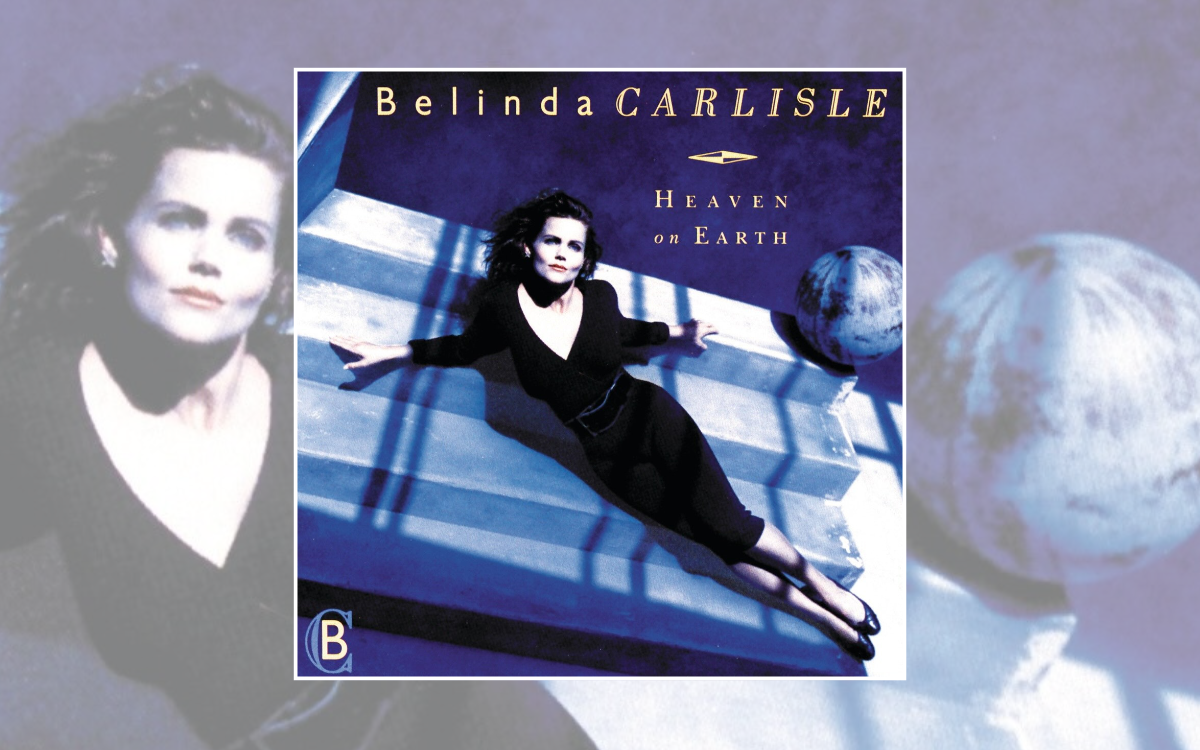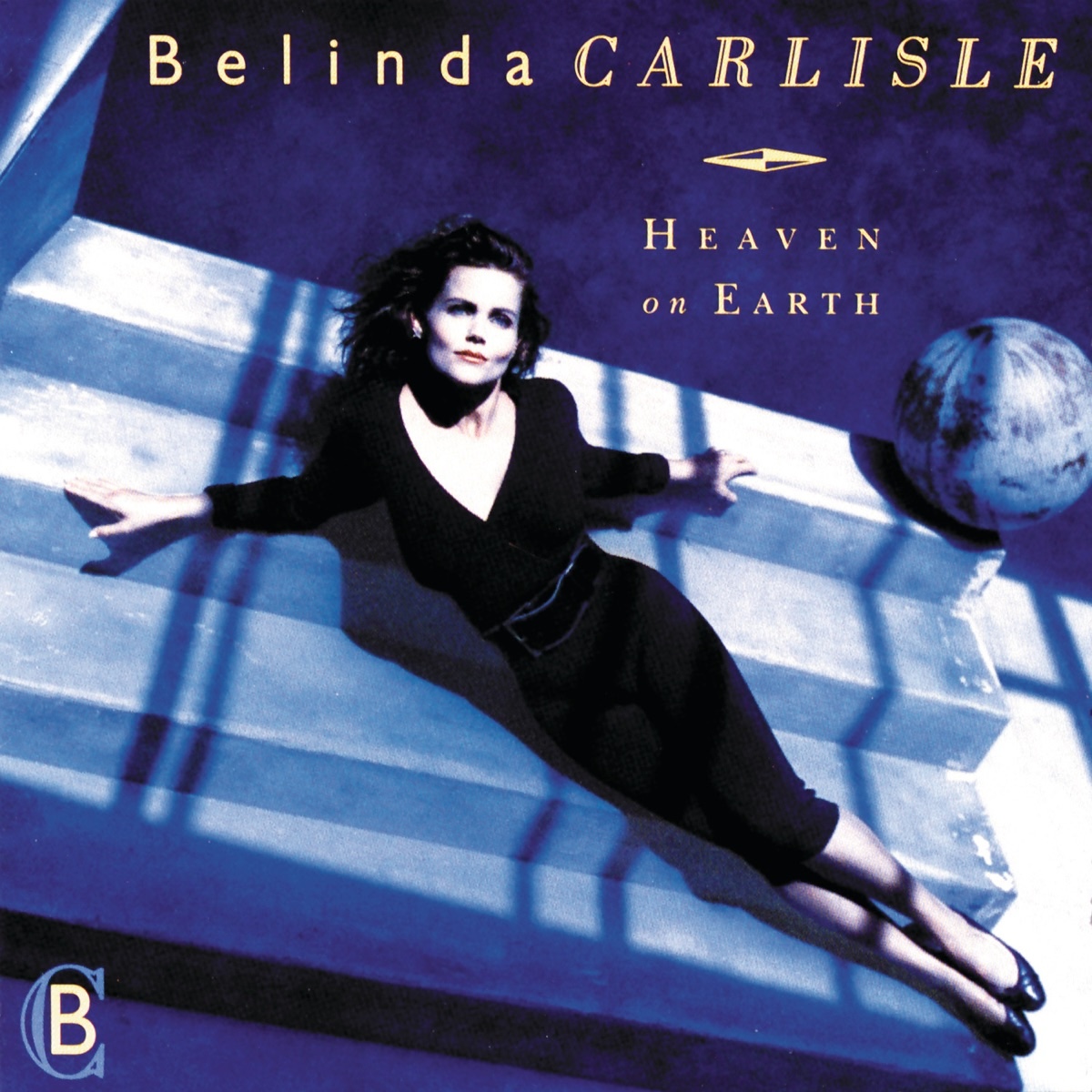The Go-Go’s frontwoman-turned-solo star shines on her second solo LP

Heaven On Earth, the second album from The Go-Go’s frontwoman-turned-solo star gave Belinda Carlisle a huge No.1 single that became a timeless anthem. It’s a confident coming-of-age statement, which ensured her ascent from dive bar to diva.
Belinda Carlisle’s 1987 single Heaven Is A Place On Earth is so thoroughly woven into the fabric of modern life, it’s hard to imagine a time when it didn’t exist. Ubiquitous and comfortingly familiar, it swiftly became a jukebox staple and continues to pop up with regularity. Its parent album, abbreviated to Heaven On Earth, is an equally significant cultural marker that cemented the singer’s place in pop history.
Following the huge success and subsequent demise of Los Angeles’ all-female new wavers, The Go-Go’s (who themselves had enjoyed six weeks atop the Billboard Album Chart with Beauty And The Beat), this record affirmed her status as a global solo star. Carlisle’s first solo album, 1986’s eponymous Belinda, showed promise, producing a Top 3 US hit, Mad About You. But, in truth, that record was somewhat patchy. Bags of fun, but still largely indebted to 60s girl group gone new wave – in other words, a slightly poppier Go-Go’s, rather than an artist forging a distinctive sound of her own.
Heaven On Earth, however, would prove to be a coming of age.
Imposter Syndrome
Not that many artists successfully make the transition from group member to solo star. Speaking to Classic Pop in 2017, Carlisle acknowledged: “It was very intimidating going solo. I had to really find my feet… “I was really insecure about being out there as the complete focus. I couldn’t bounce things off other people on stage.” Later, she notes of that time, she “felt like an imposter for years”.
However, the powers-that-be clearly had belief, judging by the considerable studio resources allocated to the project. Even for a time when label money was being thrown around quite excessively, nailing Carlisle’s record seems to have been considered a big priority. It was her first album for the label MCA, having so far built her career with Miles Copeland’s I.R.S., and the move signified a considerable step up. There was a fair amount riding on its success, both for the label (which desperately needed a hit after some restructuring) and Carlisle herself, looking to reassert her presence.
Since the release of 1984’s Talk Show, the last Go-Go’s album before the band’s 2001 return, a new star had risen in their wake: Madonna, who was, coincidentally, born exactly one day before Belinda in the same year. A retooled Carlisle could be MCA’s solution, though adopting a more guitar-driven approach, compared to Madonna’s dance-oriented club focus.
Turbo-Charged Power Pop
Indeed, Heaven On Earth has a more muscular sound than Carlisle had ever presented before. She traded The Go-Go’s breezy, sugary vibe for something meatier, reflecting the turbo-charged power pop production techniques then developing in the mid-80s. Her voice is audibly richer, too; fuller-bodied, toning down the higher-pitched bubblegum sound that was still evident on her solo debut.
Part of this might be explained by the walls of stacked powerhouse backing vocals. But even in the subtler moments, when it strips back to just Belinda’s bare vocal, there’s a mature world-weariness to her delivery. More diva than dive bar.
Carlisle underwent an obvious image transformation, too. Her styling evolved from the punky chic of The Go-Go’s to a more iconic and glamorous ‘leading lady’ look. This very deliberate aesthetic shift is announced on the cover of Heaven On Earth – beautifully shot, cheekbones accentuated in shadow, like a timeless star of the silver screen.
LA Woman
Production duties and much of the songwriting were handled by Rick Nowels, then a relative newcomer who had recently made his name with Stevie Nicks. A childhood acquaintance of Nicks, he co-wrote her single I Can’t Wait and took on wider co-production for the album Rock A Little (1985). Though today a top-tier writer for the stars, at that point he was still largely unproven himself. It was Nicks who apparently suggested that Carlisle seek him out, to take her career to the next level.
The album was recorded in various studios around Hollywood, which seems to have rubbed off on its sound.
Heaven On Earth has that West Coast, Golden State sunshine embedded into its very core. Much of that essence probably has to do with the top LA session players who performed on the record. Among the many California luminaries, backing vocals were provided by Michelle Phillips of The Mamas & The Papas, and the late Brian Wilson’s daughter, Carnie. Token Londoner Thomas Dolby pops up on keyboards. The wider credits list is a roll call of top-flight sessioners, well-known in studio circles.
To pick just one example at random, guitarist Dann Huff was simultaneously employed on Michael Jackson’s Bad in the same year. The result sounds expensive.
Despite the army of contributors (at least seven guitarists are listed alone), it still sounds remarkably consistent across the 10 tracks. From the off, Heaven On Earth asserts a clearly defined sound that’s maintained throughout. You know what you’re getting: solid drivetime pop-rock. There won’t be an arty monologue halfway through; a ham-fisted rap to get onto R’n’B playlists; or a cynical club banger hoping to light up the dance charts. As Carlisle has affirmed over the years, she knows her strengths, she knows her limitations, and evidently, she knows the market the record is aimed at. The album is all the better for it.
Anthemic Rock
The record sounds incredibly bombastic in that late-80s American way – with huge drums, huge guitars, huge vocals. It sits comfortably at home with the drivetime radio of the era – Springsteen, Bon Jovi, Bryan Adams etc.
In a retrospective interview with the BBC’s Mark Goodier, Carlisle remembers metal band Anthrax recording in the studio next door. In the same discussion, she talks of retaining her punk spirit, even as she transcended it to become a pop star.
Her singing isn’t particularly flashy or technical, but it’s authentic and honest – Carlisle delivers her anthems with compassion and heart, free of ostentation. But she more than ably holds her own, living up to those gutsy arrangements; always ensuring her personality shines through.
As for the songs, the writing took a big step up, too, from the first album. Nowels worked with fellow songwriter, Ellen Shipley, herself a minor 80s solo star, to compose two of the key singles: Heaven Is A Place On Earth and Circle In The Sand. Meanwhile, four of the tracks were written or co-written by Carlisle’s former Go-Go’s bandmate, Charlotte Caffey. And another worldclass songwriter, Diane Warren, provided two more.
Punk Spirit
In an alternative universe, Waiting For A Star To Fall (a huge smash for its writers, Boy Meets Girl) could have been a hit for Carlisle. Although reluctantly demoed for the album, Belinda steadfastly refused to include it. A rough bootleg demo can be found if you know where to look.
Hindsight, of course, is invaluable, but her reticence is interesting given that it’s arguably stronger material than at least one or two offerings on this record. Maybe the ex-punk felt it was just a little too saccharine for her tastes; still she could easily have clad it in heavy armour and blasted it out the park.
Its rejection, coupled with another Warren-penned track, Some Hearts (later a hit for Carrie Underwood), proves unequivocally that Carlisle would only release something she had a personal affinity with.
Heaven On Earth achieved No.13 on the US Billboard chart (which, in truth, feels surprisingly low given its ongoing cultural resonance), and was a UK No.4 hit. However, it faired even better in other territories, reaching No.1 in Norway (a-ha obviously didn’t have a record out that week).
Today, it remains a fine collection that deserves revisiting. Heaven Is A Place On Earth regularly pops up in film and TV. But the weighty album opener is almost too substantial – a star that shines so phenomenally bright, it blinds everything within range. The rest of the record is solid, too, and several of its companions are deserving of more attention.
Immediate Impact
Heaven On Earth enabled a second bite of the cherry for Carlisle – by her own admission (in various interviews) a rarity, not to be taken for granted. The lead single was nominated for a Grammy, ultimately losing out to Whitney Houston’s I Wanna Dance With Somebody – not that Carlisle could have too much cause to argue with that.
Heaven On Earth’s immediate impact is evident from the line of superstars queuing up to appear on its follow-up, Runaway Horses, including Bryan Adams, Steve Lukather and George Harrison.
But even the presence of rock royalty could not make it eclipse its predecessor. Heaven On Earth remains Carlisle’s commercial peak as a solo star, and produced her last Top 10 US single, although she continued to have Top 10 hits in the UK and other territories.
By and large, there’s nothing particularly groundbreaking in the production or song choices, besides perhaps an innovative version of Cream’s I Feel Free. But the record wins out on its huge hooks, big heart and sheer strength of conviction.
It’s an unashamedly mainstream record, yet it retains its integrity. It is Belinda Carlisle’s proper ‘grown up’ record, but – most importantly – she achieves this feat without losing the sense of fun that won everyone over in the first place.

THE SONGS
Heaven Is A Place On Earth
A strong contender for the most bombastic opening to a pop song ever. The phrase ‘power chord’ was surely coined to describe this track. Heaven Is A Place On Earth adheres to the George Martin school of arranging, by whacking the hook upfront (otherwise known as ‘don’t bore us, get to the chorus’). Just a thunderous kick drum, then boom!, straight into that famous singalong refrain delivered by multilayered vocals. In fact, the immediate touchstone for the track was Bon Jovi’s You Give Love A Bad Name. The lyrics were apparently inspired by a truckstop postcard. Not Shakespeare then, but sometimes, you need that blunt, direct message to break through, and its universal theme continues to resonate. Needless to say, it conquered the charts practically everywhere and remains Carlisle’s only US Billboard No.1 single to date. The chutzpah is capped off with the obligatory final-chorus key change. Heaven… has taken on a life of its own, a classic pop-rock anthem and jukebox standard.
Circle In The Sand
Infinitely more subtle than the opener; and though not as immediate, Circle In The Sand is arguably more musically interesting. Rather than building up in linear fashion to an explosive singalong chorus, it simply skulks along with a circular quality. The lyrics instantly conjure imagery of a sandy beach at sunset, piña colada in hand. The arrangement has an ethereal shimmering quality, thanks to Thomas Dolby’s keyboards, combined with session players John McCurry and John Pierce on guitar and bass respectively. Another Top 10 single.
I Feel Free
A spirited cover of the Cream favourite. A refreshing and unexpected delight – far better in reality than it might seem on paper. The trippy, sampled male vocal refrain in the opening bars feels genuinely innovative and fresh even now. Where Heaven Is A Place On Earth’s overbearing production might understandably feel a little stodgy to some, this track positively jumps out of the speakers as a futurist punch contrasted with throwback psychedelia. Released as a single, in the US it reached a paltry No.88, but deserved to be a much bigger hit for Carlisle. It also features in the 1988 ‘two Coreys’ film, License To Drive.
Should I Let You In?
The first of several co-writes from Belinda’s ex-Go-Go’s pal, guitarist Charlotte Caffey (along with Australian, Mark Holden on this track). Should I Let You In? kicks off with an ominous tribal drum pulse, before erupting into more standard pop-rock fair, echoing The Go-Go’s new wave style, though more muscular and tooled up. The guitars ring out with a satisfying jangle, and when combined with the vocal, the effect is like Blondie meets The Byrds. Carlisle exercises her strong vibrato, affecting a raspy voice, which is embellished with era-typical guitar licks (caked in delay, chorus and every other effect available). A fine album cut, it’s tailor-made to soundtrack some generic late-80s primetime TV show, probably starring David Hasselhoff.
World Without You
The first of two tracks in a row on the album that was written by Diane Warren. World Without You is a sweet, silky song showcasing a softer falsetto chorus, that floats along gently on a vaguely doo-woppy, girl-group vibe. Released as a single, it reached No.34 in the UK.
I Get Weak
Songwriter Diane Warren apparently “had Stevie Nicks in mind” when she first shared I Get Weak with producer Rick Nowels. But it was deemed a great fit for Carlisle, and so Stevie’s loss was Belinda’s gain. It’s a fine cut, similar in style and tone to World Without You, and less in-yer-face than some of its counterparts. But it’s effective. Nevertheless, there’s a cute likability to the lilting melody over the descending chords. Though essentially a ballad, the new wave stylings and driving backbeat keep the momentum going, rather than descending into a more plodding or sludgy affair. It was another hit, just missing the No.1 spot in the US, while also making the Top 10 in the UK.
We Can Change
The pace picks up once again with the help of bright synth chimes (seemingly using the same keyboard preset as Born In The U.S.A.) and more jangly guitars. It’s another Caffey co-write (this time with Nowels), and again has a distinct Go-Go’s feel – an upbeat song, with a positive message about making the world better by first starting with ourselves. Indeed, presumably by sheer coincidence, it shares the same lyrical sentiment as Michael Jackson’s Man In The Mirror (released on his Bad album in the same year).It’s catchy, for sure. The arrangement hits in all the right places – just try resisting the urge to sing along to all those “whoa, whoas!” in the chorus. Ultimately though, the lyric lets it down – just a little too anodyne due to its naïve, happy-clappy optimism.
Fool For Love
Another up-tempo rocker, with all the usual production embellishments: a cavernous snare drum, chugging guitars and brash sparkly synths. Fool For Love was written by Robbie Seidman, who has penned several songs for Carlisle throughout her career. Fool For Love occupies that spot in the tracklisting often reserved for the weaker material (that is, tucked away in the middle of Side B). On first impression, it feels a little lightweight; not awful, by any stretch, but neither does it ever quite catch fire. But in fairness, it’s a grower that improves with time. You certainly won’t forget the title – repeated endlessly in the refrain throughout.
Nobody Owns Me
A rallying cry to the independent spirit – “no-one owns me and no-one can ever tell me what to do”, Carlisle declares with genuine conviction (although the song title fails to mention the lyrics’ caveat of “nobody but you”). Of course, Carlisle did show that she was not prepared to be pushed about, refusing to include certain songs on the record that she wasn’t keen on. So, this track holds particular resonance. True to its sentiment, Nobody Owns Me is one of several high-octane rockers (again a Caffey co-write), similar in energy and intensity of the preceding track, though packing a much bigger punch.
Love Never Dies
The record ends on a more plaintive note; a yearning, heart-aching slowburner ballad, with a title straight out of a Bond film. In style and volume, it’s the polar opposite of the opening track – but lyrically, they share an obvious kinship, together neatly bookending the album. Love Never Dies features a dynamic vocal that builds in intensity from a whisper to raspy pleading – indeed it’s that rawness that rescues it from potential sappiness, Carlisle’s voice often on the edge of breaking. When she soars into those long held notes in the chorus refrain, it’s incredibly touching, without any of the Disney Princess sheen that so typically accompanies a rousing ballad like this. It occupies a similar space to Kim Carnes’ 1981 hit, Bette Davis Eyes. A single in the UK (impressively, it was her fifth on these shores from the 10-track album), though it criminally missed the Top 40, peaking at No.54 in 1988.
For more Belinda Carlisle, click here
Subscribe to Classic Pop magazine here
Classic Pop may earn commission from the links on this page, but we only feature products we think you will enjoy.


